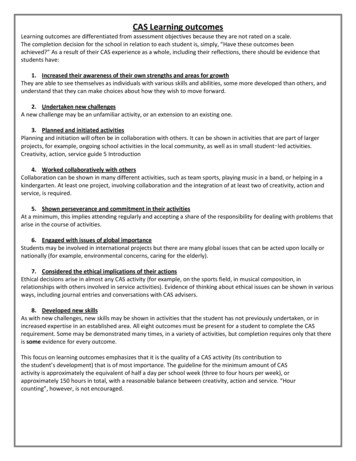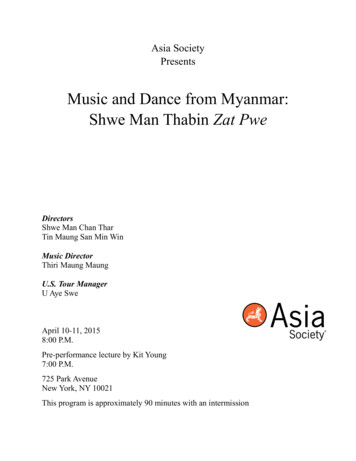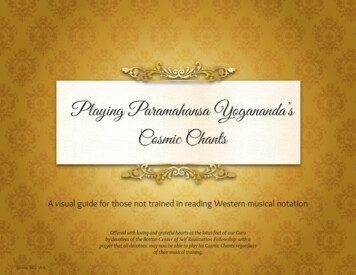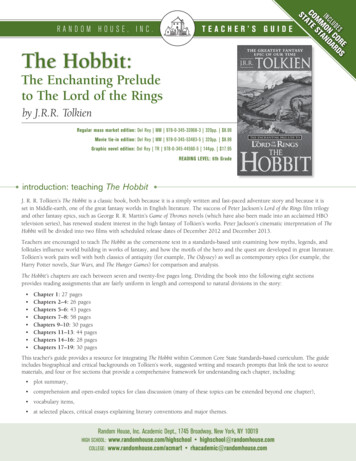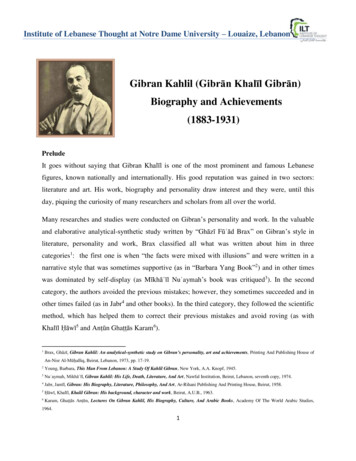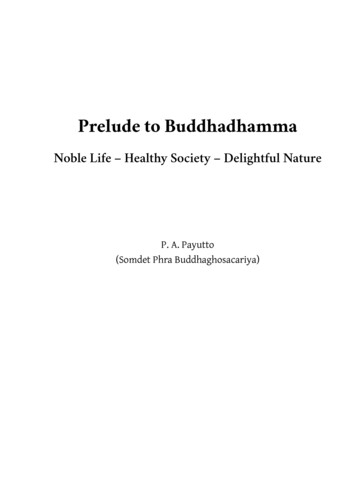
Transcription
Prelude to BuddhadhammaNoble Life – Healthy Society – Delightful NatureP. A. Payutto(Somdet Phra Buddhaghosacariya)
Prelude to Buddhadhamma: Noble Life – Healthy Society – Delightful Natureby P. A. Payutto (Somdet Phra Buddhaghosacariya)translated by Robin Moore 2018 English edition – Robin MooreOriginal Thai version frst published: 24 April 2016Translated English version frst published: November 20183,000 copiesTypeset in: Crimson, Gentium, Open Sans and TF Pimpakarn.Cover design by: Phrakru Vinayadhorn (Chaiyos Buddhivaro)Layout design by: Supapong AreeprasertkulPrinted by:Phlidhamm Publishing, under Pet & Home Publishing House Co., Ltd.23 Soi 6, Mooban Suanluanglaemthong 2, Pattanakarn Rd., Suanluang, BangkokTel. 0-2750-7732, Email: petandhome@gmail.com, Website: petandhome.co.th
iAnumodana – AppreciationAbout fve years ago, the Buddhist congregation at Wat Nyanavesakavan, bothmonastics and lay supporters, deemed that it was a ftting time to put concerted efortinto translating Dhamma books into English and to publish them in a determined,systematic fashion. At that time, Mr. Robin Moore was entrusted with the responsibility of doing the translation work, with Khun Peeranuch Kiatsommart faithfully andgenerously providing all fnancial assistance.Before long, in 2016, two Dhamma books translated into English were completed,namely: The Unheralded Value of the Vinaya and True Education Begins with Wise Consumption.1 In the next two years, these were followed by another two books: Honouring theClaim: ‘We Love the King’ and Education Made Easy.2This year, 2018, four new books have been completed and are being prepared forpublication, namely: May the Days and Nights Not Pass in VainPerfect HappinessGrowing in MeritPrelude to Buddhadhamma: Noble Life – Healthy Society – Delightful Nature3The study, teaching, and propagation of the Dhamma, along with its accompanying practice and realization, whereby the Dhamma becomes embodied in individualsand society, lies at the heart of Buddhism. Translating and publishing the Dhamma arekey meritorious deeds enabling this process to reach success and fulflment.I wish to express my appreciation to Mr. Robin Moore for performing this important work with diligence and determination.This wholesome work has been accomplished as a ‘gift of the Dhamma’ (dhammadāna) by way of the patronage and supervision of Khun Peeranuch Kiatsommart. Shehas acted with devotion to the Triple Gem, enthusiasm for promoting the study anddissemination of Dhamma, and great goodwill and kindness towards practitioners ofDhammavinaya; indeed, towards all people. May I express my gratitude to Khun Peeranuch Kiatsommart for her dedication and assistance, which has enabled this gift of theDhamma to come to fruition. These eforts and achievements promote wisdom andtruth, leading to long-lasting value and beneft.P. A. Payutto (Somdet Phra Buddhaghosacariya)21 September 2018123Original titles: วินัย �คิด & ��.Original titles: ทำาอย่างไร �า “เรารักในหลวง” & riginal titles: �ล่า, �, ก้าวไปในบุญ & บทนำาสู่ พุทธธรรม, respectively.
ii
iiiPreface(From the First Edition)This book Prelude to Buddhadhamma: Noble Life – Healthy Society – Delightful Nature aroseunexpectedly and spontaneously, and from no outside entreaty or appeal. Whatoccurred was that an important organization posed a question on Dhamma, and I felt itnecessary to send them an answer and explanation. Although this explanation was notlengthy, I felt that it summarized the key principles of Buddhism. Were I to elaborateon this text, I thought, it could be a supplement or companion volume to the bookBuddhadhamma—a form of introduction or synopsis. I therefore, in a limited amount oftime, edited and added to the text.The entire subject matter of this book is already contained in the revised andexpanded edition of Buddhadhamma.1 Some readers new to the Buddha’s teachings,however, may feel that, by reading the expanded edition of Buddhadhamma, they are ina sense jumping into a vast ocean without any sight of dry land, unable to piecetogether or arrange the material into any coherent shape. This book Prelude toBuddhadhamma may be of assistance to these readers, both as an introduction—providing a glimpse of essential points for study and understanding—and as a synopsis—leading to a practical application of the teachings in daily life and in society, wherebythe world is our arena and the setting in which we live out our destiny.Some people have expressed discomfort with having an excess of technical detailsin this book. For this reason, I have omitted most of the scriptural source references. 2The publication of this book was completed by relying on a government publicfund under royal patronage, following royal tradition. This book published for freedistribution is thus dedicated to the virtue of the royal family, similar to the occasionof obtaining support while preparing the revised and expanded edition of Buddhadhamma in 2012.On the occasion of completing this gift of the Dhamma, may everyone who hasparticipated in this auspicious deed fourish in peace and happiness, and grow ineverything wholesome. May the true Dhamma prosper and endure for the wellbeingand happiness of all people.P. A. Payutto (Somdet Phra Buddhaghosacariya)13 April 20161Trans.: note that this book expands on some principles only covered in brief detail inBuddhadhamma.2Trans.: where necessary, I have added references to source material, which do not appear inthe original Thai text.
ivPreventing Future DangersThe Pali Canon contains four consecutive groups of teachings by the Buddhaon future dangers. In each of these groups he mentions fve distinct dangers,warning the monastic community to make an efort to avert them. 1 In someof these teachings, the Buddha is cautioning specifc kinds of individuals,while in others he is cautioning the community of monks on the whole,without exception.The frst group of teachings pertains to forest-dwelling monks. Thesecond group of teachings pertains to all individual monks. In both cases, theBuddha is warning the monks to be vigilant, urging them to make efort torealize those states that remain unrealized. The third and fourth groupspertain to the entire monastic community; here, he is urging the monks torecognize fve dangers that at that time had not yet arisen, but will arise inthe future. The monks should endeavour to prevent them and rectify thesituation if they have begun to arise.Here, only the frst factor of the third group of teachings is presented. Itpertains directly to protecting the Dhammavinaya—to transmitting andpreserving the Buddha’s Doctrine & Discipline.Monks, there are these fve future dangers as yet unarisen that will arise inthe future. You should recognize them and make an efort to prevent them.What fve?In the future there will be monks who are undeveloped in body,undeveloped in morality, undeveloped in mind, and undeveloped inwisdom.2Despite being undeveloped in body, morality, mind, and wisdom, they willbestow full ordination to others3 but will not be able to guide these ordainees in higher virtuous conduct, higher mind, and higher wisdom.41234A. III. 100-110.I.e., they lack mastery over the body (bhāvita-kāya), mastery in virtuous conduct (bhāvitasīla), mastery over the mind (bhāvita-citta), and mastery in wisdom (bhāvita-paññā). In otherwords, they are defcient in physical development (kāya-bhāvanā), moral development (sīlabhāvanā), mental development (citta-bhāvanā), and wisdom development (paññā-bhāvanā).I.e. they will act as preceptors.Adhisīla, adhicitta, and adhipaññā.
vThese ordainees too will be undeveloped in body, morality, mind, andwisdom. They in turn will give full ordination to others but will not be ableto guide them in higher virtuous conduct, higher mind, and higher wisdom.These ordainees too will be undeveloped in body, morality, mind, andwisdom.Thus, monks, through corruption of the Dhamma comes corruption of theDiscipline, and from corruption of the Discipline comes corruption of theDhamma.This is the frst future danger as yet unarisen that will arise in the future.You should recognize it and make an efort to prevent it.From Completion of the Threefold Trainingto Completion of the Fourfold DevelopmentThe Buddha’s Teachings, known as Buddha-Dhamma, describe a truth ofthe world and of human existence in line with natural laws. When peopleunderstand this truth, they live correctly and develop their lives to perfection. They are able to attend to themselves, their communities, and theentire world in a wholesome, positive way, living in harmony and withdignity.The Buddha’s words quoted above describe the practice of the threefoldtraining (the three sikkhā), culminating in a person gaining self-mastery infour aspects, i.e. to being ‘fully developed’ (bhāvita)—to having completedthe fourfold development (bhāvanā). This term bhāvita conveys the goal ofBuddha-Dhamma.1 The relationship between the threefold training, thefourfold development, and the fourfold self-mastery, should be clearlyunderstood.This book Prelude to Buddhadhamma aims to clarify this relationship.1Trans.: note that bhāvita is the past participle of the verb bhāveti. It can be used as an epithetfor an arahant, in the sense of being an ‘adept.’
Table of ContentsAnumodana – Appreciation.iPreface (From the First Edition).iiiPreventing Future Dangers.ivFrom Completion of the Threefold Training to Completion ofthe Fourfold Development.vPrelude to Buddhadhamma:Noble Life – Healthy Society – Delightful Nature.11. Delightful Natural Environment.1Birthplace of Buddhism.1Abundant Water & Rich Flora.4Noble Beings Dwell in Delight.7Sense Restraint and Creating Places of Delight.102. Performing Good Deeds & Fostering a Harmonious Community.14Preserving Traditions – Protecting Buddhism.14Promoting a Land of Delight & Fostering a Healthy Community.18Buddhist Customs Beneft Thai Society and Protect Buddhism.23Monks and Laypeople: Working Together in Goodness.263. Development Leading to Fourfold Mastery.30A. Physical Development Does Not Refer to Fortifying the Body.31B. Moral Development and Social Improvement.35C. Three Aspects of Mental Development.37Concentration (samādhi): a Keyword for Mental Development.42D. Wisdom Development: Wisdom Comes, Problems GoCessation of Sufering & the Bliss of Liberation.45Appendix 1: Scriptural Source Material for the Four Kinds of Bhāvanā& Four Kinds of Bhāvita.50Appendix 2: Fourfold Development.50
Prelude to Buddhadhamma:Noble Life – Healthy Society – Delightful Nature1. Delightful Natural EnvironmentBirthplace of BuddhismA signifcant series of events in the Buddha’s life, acting as a key juncture inthe origin of Buddhism, occurred during the time after the Buddha wentforth into the homeless life (still as the Bodhisatta). 1 First, he travelled torenowned hermitages to practise the doctrines taught by the chief teachersresiding there. Having completed his studies, he came to the conclusion thatthese doctrines do not lead to the fnal goal. He therefore abandoned thesepractices and followed his own path, looking for a suitable place to applyhimself to his spiritual inquiries.Finally, the Buddha was able to fnd such a suitable place at the village ofSenānigama in Uruvelā. On this occasion, he uttered some verses, which arerecorded in four suttas of the Tipiṭaka,2 as follows:This is a truly delightful place, 3 with sheltered, pleasant groves and a clearflowing river with smooth banks, and nearby a village for alms resort. Thiswill surely serve for the striving of a clansman intent on striving.Indeed, Monks, I sat down there determining: ‘This place is suitable forstriving.’In this delightful place of Uruvelā the Buddha realized awakening. It canthus be considered the birthplace of Buddhism, as confrmed by the passagesin the Tipiṭaka:41234Trans.: Sanskrit: Bodhisattva.In the Pāsarāsi Sutta (M. I. 160-75), Mahāsaccaka Sutta (M. I. 237-51), Bodhirājakumāra Sutta(M. II. 91), and Sagārava Sutta (M. II. 209-13), respectively. [Trans.: the Pāsarāsi Sutta is alsoknown as the Ariyapariyesanā Sutta; the Sagārava Sutta is also known as the SangāravaSutta.]Ramaṇīyo vata bhūmibhāgo.Vin. I. 1.
2Prelude to Buddhadhamma: Noble Life – Healthy Society – Delightful NatureAt that time, newly awakened, the Blessed One was dwelling at Uruvelā,sitting cross-legged at the foot of the Bodhi Tree, near the banks of theNerañjarā River, enjoying the bliss of liberation for an entire week.On that occasion, throughout the frst watch of the night, the Blessed Onemeditated on Dependent Origination, both the forward and reversesequence, thus: ‘With ignorance as condition, there are volitional formations .’It was here at Uruvelā that the dissemination of Buddhism had its roots,and it was from here that the Buddha set forth to spread his ministry far andwide.(Artists commonly portray in paintings and illustrations this importantincident in the Buddha’s life, when he was sitting under the refreshing shadeof the Bodhi Tree, enjoying the bliss of liberation. The image of the BodhiTree situated on the banks of the Nerañjarā River is an apt symbol for natureconservation and environmental protection. It can be summed up by thephrase: ‘truly delightful region’ (with pleasant groves and clear fowingwater)—ramaṇīyo vata bhūmibhāgo.)Soon thereafter, when the Buddha was proclaiming the Dhamma at thecity of Rājagaha, the capital of the Magadha state, King Bimbisāra gainedfaith in the teachings and ofered the royal park of Veḷuvana, known as theBamboo Grove, as a residence for the Buddha and as a place for the bhikkhusangha to practise the virtues of a renunciant.1 The Buddha announced:‘Monks, I give permission for a monastery.’2 This is the origin of the frstBuddhist monastery.In Pali, the word for ‘monastery’ here is ārāma, which can also be translated as ‘park,’ ‘grove,’ or ‘garden.’3 An ārāma is a delightful place (ramaṇīya).(These two terms have the same root: ārāma is a noun and ramaṇīya isan adjective.)123Samaṇa-dhamma.Anujānāmi bhikkhave ārāmaṃ; Vin. I. 38-9.Most frequently it is found in the terms pupphārāma (fower garden) and phalārāma (fruitorchard).
P. A. Payutto (Somdet Phra Buddhaghosacariya)3The royal park of Veḷuvana falls under the category of an ārāma. It wascalled Veḷuvanārāma.After this time, other laypeople built and ofered monasteries, or theyofered woodland areas on which a monastery could be built. The number ofBuddhist monasteries thus gradually grew in number. Every one of thesemonasteries had the distinctive feature of being a place of delight: 1 a beautiful, refreshing, and pleasing place.In the scriptures, the term ramaṇīya is used frequently. In poetic verse,however, this term is relatively long and slightly clumsy. For this reason,the term ramma is used instead, reducing the number of syllables from fourto two. But these two terms have identical meanings.When the wealthy merchant Anāthapiṇḍika ofered Jetavana Monasteryto the sangha, the Buddha said to him: ‘Build a delightful residence for themonks.’2Ever since ancient times, rishis, hermits, and ascetics have given importance to—one can even say they have observed the standard and guideline of—seeking out and creating delightful abodes. Vessantara, for instance, builta hermitage of this description.3 Even a simple leaf hut4 is a refreshing,delightful abode close to nature.In Pali, the defnition for being a delightful, charming, and beautifulplace is expanded to include the abodes of celestial beings, monarchs, andwealthy merchants. Here, the beauty and charm refers to a place aboundingin ornate, imposing, and stately adornments and decorations.But even in reference to a magnifcent celestial mansion, for such a placeto be considered ‘delightful,’ it must possess the essential feature of being setamongst a refreshing and revitalizing natural surrounding.3Ramaṇīya.Vihāre kāraye ramme; Vin. II. 164.Trans.: the Vessantara Jātaka tells the story of one of the Bodhisatta’s previous lives, asPrince Vessantara. The story is often referred to as that of a birth in which the Bodhisatta’sperfection of generosity (dāna-pāramita) reached its culmination.4Paṇṇa-sālā.12
4Prelude to Buddhadhamma: Noble Life – Healthy Society – Delightful NatureAbundant Water & Rich FloraPeople’s abode and residence should possess the essential characteristic ofbeing delightful and refreshing. This holds especially true for monasteries.A monastery should have the following features: frst, it is situated close tonature; and second, it is built conforming to the prescriptions outlined in themonastic disciplinary code (the Vinaya). By looking after the monastery andkeeping it clean, safe, and pleasing, the monks experience a happinessmarked by peace and tranquillity. 1 This difers from many laypeople, whoadorn and decorate their dwellings as a means to show of their prestige andwealth. In this case, the sense of being delightful may simply mean amusing.The pleasure they derive is merely based on comfortable surroundings 2 orbased on being entertained.3The main attribute—one can say the minimum qualifcation or criterion—of a delightful place, frequently mentioned in the scriptures, is a plenitudeof water and shade (a ‘wealth of shade and water’). 4As mentioned above, the Buddha described the village district ofSenānigama as follows: ‘With shady, delightful groves and a pleasant, clearfowing river.’The scriptural descriptions of delightful places abounding in water andshade are multiple and varied. Here is another example: ‘Lotus ponds withclear, sweet, cool, pristine shimmering water, with smooth banks instillingdelight, abounding with diverse trees casting shade.’Following on from the essential attributes of water and shade, the nextcharacteristic of a delightful place is ‘completeness of region.’ 5 This refers toa region, locality, neighbourhood, land, etc. that is clean, tidy, unpolluted,well-ordered, safe, pleasing on the eye, worthy of regard, and attractive,with smooth terrain conducive for walking. Uruvelā is an example of sucha region, where the banks of the rivers were gentle and sukha.Chāyūdaka-sampatti; chāyā shade; udaka water. This compound is also spelled chāyodaka.Bhūmibhāga-sampatti.
P. A. Payutto (Somdet Phra Buddhaghosacariya)5Some scriptural descriptions mention wide sandy beaches or extensivebeds of sand, as if the land was paved by silver sheeting or covered by goldleaf. These descriptions further embellish the landscape, adding details ofthe breeze, the sunlight, the sky, the bright moonlit nights, and the clear airfree of dust and haze. These elaborate descriptions are the province of poets.The next characteristic is ‘completeness of coming and going’: 1 the placeis not too far from human habitation, nor is it too near; it is easily accessibleand convenient to travel to.This characteristic is linked with ‘completeness of individuals’: 2 the placeis not inhabited by evil-minded people; instead it is inhabited by virtuous,wise, and trustworthy people, who are able to impart their knowledge andunderstanding. These two characteristics are especially important for themonastic sangha, whose residence should be quiet and peaceful, notcrowded or congested, and suitable for solitude.Buddhism gives great import to people’s abode and place of residence. Itencourages people to select and establish a residence that is delightful andrefreshing, supporting good health and enhancing the spirit. This is a basicprinciple incorporated in the frst main tenet, i.e. physical development, 3 aspart of the overall system of human spiritual development.(In a strict sense, physical development is defned as development of the‘body consisting of the fve sense doors.’4 The body is the assembly point ofall pathways of cognition whereby we communicate with the world or theexternal environment. In a broader sense, this term thus refers to cultivating the entire spectrum of sense contact, by way of the eye, ear, nose,tongue, and body. In this process, one develops sense-restraint, 5 associatingwith the world with mindfulness and thus generating success in one’s spiritual atti.Kāya-bhāvanā.Phassadvāra-kāya; ‘body consisting of the fve pathways of sense contact.’Indriya-saṁvara.
Prelude to Buddhadhamma: Noble Life – Healthy Society – Delightful Nature6People’s dwellings and places of residence, including work places andsurrounding environment, act as the platform and foundation for their lives.It is here that people earn their livelihood, undertake various activities, workon improving themselves, and experience the many joys and sorrows of life.Life begins and ends at home.People’s place of residence is the link between the human world and thenatural world, which supports all human activity. It is thus of vital importance that people preserve and protect a refreshing, healthy, and fourishingnatural environment.There are many examples from human history of what happens whenthis essential state of wellbeing and completeness is severed—when peopleare deprived of shade and water—when the wellsprings dry up and theforests are felled. Very soon conditions become harsh and severe. Peoplethen need to migrate and move their settlements elsewhere. Prosperouslands turn into wasteland and become deserted. If the situation becomescritical, independent nation states are lost and entire civilizations collapse.There are two ways of looking at human beings. First, one views peopleas separate personalities,1 part of a social entity. Although these individualsderive various forms of pleasure from society, e.g. wealth, fame, praise,amusement, etc., these forms of happiness are relatively shallow and superfcial. They can be seen as fabrications—as social embellishments. They haveno reliable or enduring substance.Second, one views people as living organisms,2 part of a natural system.This refers to the essential nature of human beings. It is here, at the heart ofthis living organism, that we are able to witness and validate true, intrinsichappiness. To realize genuine satisfaction, people need to experience a spiritual happiness inherent in and connected to nature. This deeper form ofhappiness sufuses the heart and acts as a foundation for one’s life.12Puggala.Jīvita.
P. A. Payutto (Somdet Phra Buddhaghosacariya)7In sum, at a basic level, people should be provided with the opportunityto experience joy by abiding in a delightful and refreshing natural environment. This begins with the land—the forests, rich vegetation, numerousspecies of fowers, and mountains—and with clear, unpolluted lakes andrivers. Moreover, the region is endowed with sunshine, pleasant breezes,and fresh air.Noble Beings Dwell in DelightThose beings who have fully realized the Dhamma, i.e. the Buddha and thearahants, begin their spiritual journey in a delightful natural environment.When they have completed their spiritual work, they abide in constant,unfailing happiness at all times. They experience the basic joy of continuingto live in delightful natural environments; and furthermore, wherever theydwell, regardless of the region, they make this location a place of delight forothers.As mentioned above, the Buddha, before his awakening, discovereda delightful region and decided to remain there, engaging in meditation. Andlater in his life, three months before entering fnal Nibbāna, when heprovided Ven. Ānanda with the opportunity to invite him to extend his life,he mentioned many places of delight:Ānanda, the city of Rājagaha is delightful, Mount Gijjhakūṭa is delightful,Sattapaṇṇiguhā Cave is delightful, Tapodārāma Grove is delightful, the cityof Vesāli is delightful the Pāvāla Sanctuary is delightful.1Earlier in his life, before the Buddha travelled to visit his relatives atKapilavatthu, Ven. Kāḷudāyī uttered approximately sixty poetic versesdescribing the beauty and splendour of the path they would take throughforested and mountainous regions. For example:1D. II. 116.
8Prelude to Buddhadhamma: Noble Life – Healthy Society – Delightful NatureLord Great Hero, the trees are in delightful bloom, the fragrance of theirblossoms pervading the entire forest. They cast forth their old leaves,preparing for new sprouts. Now is the right time to depart from here andtravel forth.1Having listened to these verses, the Buddha accepted the invitation andset forth on the journey.Those arahants who lived in forests and mountains would walk in themorning to a village for alms. When they returned to their dwellings, theywould delight in the natural surroundings along the way. This is evident, forexample, in the recorded verses of Ven. Mahā Kassapa:Garlanded with sacred pear,Echoing with the trumpet calls of elephants,These uplifting crags are a place of delight;These mountains do please me so!2Ever since the Buddha’s time, there has been a custom of monks meetingone another while travelling, exchanging greetings, and inquiring whethertheir respective residences are comfortable and a place of delight. Acknowledging such a greeting, a monk will normally answer in the afrmative.An example of this is seen in the Mahāgosiṅgasāla Sutta. Here, Ven. Sāriputta extends a spiritual greeting3 to Ven. Ānanda:The Gosiṅga Sāla-tree Wood is delightful, the night is clear and bright, thesāla trees are all in blossom, giving forth fragrant scents in all directions,similar to the scents of heaven. What kind of bhikkhu, friend could gracethe Gosiṅga Sāla-tree Wood?4Soon after the Buddha’s fnal passing away, the brahman Vassakāra—thechief minister of Magadha—was travelling around the city of Rājagaha oninspection, and by coincidence he met Ven. Ānanda. After a period of cordialtalk, Vassakāra made the following inquiries:1234ApA. 532; ‘delightful’ manorama.Thag. verse 1062.Dhamma-paṭisanthāra.M. I. 212.
P. A. Payutto (Somdet Phra Buddhaghosacariya)9Vassakāra: ‘Where is Venerable Ānanda living now?’Ven. Ānanda: ‘Now I am living at the Bamboo Grove, brahman.’Vassakāra: ‘Master Ānanda, is the Bamboo Grove still delightful, quiet, freeof noise and congestion, suitable for seclusion, and favourable for retreat?Ānanda: ‘Indeed, brahman, the Bamboo Grove is still delightful, quiet, freeof noise and congestion, suitable for seclusion, and favourable for retreat,because of such guardian protectors as yourself.’1The Mahā Vessantara Jātaka, also known as the Mahā Jāti, containingthirteen sections, devotes two of the sections to describing the splendourand beauty of two forested wilderness areas: the Cullavana and theMahāvana.The formal monastic discipline (Vinaya) contains prescriptions by theBuddha for the monks to look after their place of residence: to keep it clean,tidy, and pleasing to the eye, i.e. to maintain it as a ‘place a delight.’ 2 Theserules are called ‘duties pertaining to one’s dwelling.’ 3By living in close proximity to nature—to trees and woodlands—it isa regular duty for monks to sweep up fallen leaves. Monks sweeping leaveshas become iconic in Thai culture, as is seen in the chanting books, whichmention ‘sweeping the monastic courtyard’ in the list of monks’ daily practices. In like manner, keeping the monastery clean, including sweeping theleaves, is considered a means of caring for one’s preceptor and teachers.The responsibility of the monastic community to keep the monasteriesclean and tidy, ensuring that they are a place of delight, has becomea distinct part of Thai tradition, passed down through generations. Theinspiring image of a pleasant, delightful monastery has often been capturedin Thai poetry.123M. III. 13.Ramaṇīya.Senāsana-vatta.
10Prelude to Buddhadhamma: Noble Life – Healthy Society – Delightful NatureAn example of this is the poem Niras Narin, written by Narinthibet, 1praising the delightful atmosphere of monasteries and temples at the end ofthe Ayutthaya era and the beginning of the Rattanakosin era, e.g.:Temples, cloisters, pillared sanctuaries, monastic chambers and gardens,Pulpits, pavilions, courtyards, and Buddha images, shining resplendently; 2Scripture halls and temple bells chiming at eventide,Crystal oil lanterns shimmering brightly, eclipsing the light of the moon.Sense Restraint and Creating Places of DelightAccording to the essential principles outlined by the Buddha, going forthinto the renunciant life as a bhikkhu, or receiving a monastic training,involves upholding a code of discipline, called the Pāṭimokkha, whichcontains 227 training rules.3This is similar to a set of regulations established by any community orinstitution. For instance, if one enters government service, one is o
fourfold development, and the fourfold self-mastery, should be clearly understood. This book Prelude to Buddhadhamma aims to clarify this relationship. 1 Trans.: note that bhāvita is the past participle of the verb bhāveti. It can be used as an

